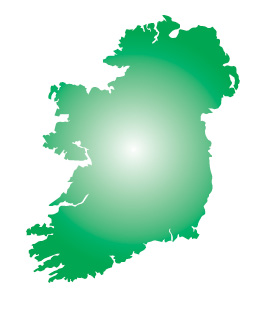Housing: land scarcity?


While several industry reports suggest that a deficiency in development land is preventing a resolution of the housing crisis, Dublin-based architect Mel Reynolds explores the figures which suggest that there is a significant volume of zoned land available.
Is land scarce? A number of construction industry reports point suggest that there is a shortage of development land. Recently the annual Knight Frank ‘New Homes Construction Survey’ provided a snapshot of the new homes construction sector by surveying residential developers. The good news for the sector is that new home construction is now viable again as prices have risen. The bad news is that the lack of suitable sites is now seen as the largest obstacle to construction. Last year agents Hooke and MacDonald said: “There is a significant lack of appropriately serviced land…The lack of availability of sites… at commercially viable prices limits the scope for supplying this sector in sufficient scale.”
A 2017 report into apartment viability by the Society of Chartered Surveyors Ireland noted that 35 per cent of a typical sales price was comprised of land value and developer’s profit-land costs are an issue. However, official figures confirm there is an abundance of zoned residential development land.
Zoned residential development land
In 2015, the Department of Housing and local authorities published the ‘Residential Land Availability Survey’, an assessment of all lands zoned for residential development in statutory development plans across Ireland. The survey confirmed that there was 17,435Ha zoned residential land nationwide with the capacity to accommodate 414,712 dwellings. In County Dublin, there is currently enough zoned land to accommodate 116,705 dwellings.
Although large land banks have been sold by the National Asset Management Agency (NAMA) to private investors and private equity funds, this is still a fraction of the overall amount of land that is available.
State controlled land
NAMA has moved to dismiss claims that it is ‘sitting’ on sites in Dublin and the Greater Dublin Area (GDA), which could be sold or otherwise freed up for the immediate development of new homes to address the housing crisis. Local authorities have similarly been criticised for ‘land-hoarding’. How much land do local authorities and NAMA own or control?
The State controls 3,008Ha of zoned residential land with the capacity for 114,123 dwellings – more than 17 per cent of all zoned residential land by area and 25 per cent of all potential dwelling capacity in the country. These figures exclude land owned by the Housing Agency, CIÉ, Coillte and other semi-state bodies such as the IDA.
The figures are more pronounced in the capital. Almost half of all residential development land in County Dublin is controlled by the State, 1,212Ha of zoned residential land with the capacity for 71,425 dwellings.
In the centre of Dublin, almost three-quarters of all residential development land is controlled by the State. The following section deals with these landholdings in more detail.
Local authority and NAMA land
In April 2017, the Department of Housing published the ‘Rebuilding Ireland Land Availability Survey’ which included details of 700 local authority, Housing Agency, State or semi-state body-owned sites, totalling some 1,700 hectares. Of this, it was confirmed that local authorities own 1,211Ha zoned residential land with capacity for 37,950 dwellings – 19,037 dwellings in County Dublin alone. It was noted at the plan’s launch that this represented only a portion of state-owned land.
Based on returns from seven local authorities, these figures are much higher. Local authorities own 1,317Ha zoned land with capacity for 48,724 dwellings nationwide and in County Dublin there is the potential to build 29,278 dwellings. Dublin City Council alone zoned enough development land for more than 18,000 dwellings.
In the private sector the picture is similar. NAMA currently control 1,691Ha zoned residential land with capacity for 65,399 dwellings, in County Dublin NAMA controls land with the potential to build 43,075 dwellings.
Between NAMA and local authorities, the State appears to control more than one-quarter of residential land capacity in Ireland.
Local authority and NAMA construction output
The Housing Agency has suggested that a minimum of 16,200 new homes are needed each year up until 2020 in order to meet demand in our urban areas. In four years since 2014, 7,200 new dwellings have been completed by NAMA debtors. In the same period local authorities built 1,200 social homes.
In September last year, there were 125,915 on housing waiting lists nationwide and more than 44,800 in County Dublin. In 2017, 17,914 new households experienced rental distress and signed-on for Housing Assistance Payment (HAP), representing one-in-six of all new tenancies registered with the Residential Tenancies Board. Just 10 per cent of annual subsidised housing demand is being met by new build social homes. This year, a further 19,600 new HAP and long-term leasing arrangements are forecast, bringing the total to 49,000. The Department of Housing’s targets for social housing builds and acquisitions have been increased by just 11 per cent on last year’s levels.
Current low rates of social housing builds are not even stabilising current housing waiting lists.

The continued lack of any meaningful affordable housing scheme is a concern. Sluggish new house-building activity and the disconnect between subsidised housing demand and affordable housing supply makes for stark reading.
Summary
Rents are continuing to set new records, increasing in double digits annually. One-third of all tenancies – more than 115,000 households – will receive up to €950 million in rent assistance in 2018. The average annual HAP cost per household is €8,256, for a household in emergency homeless accommodation costs increase to €61,000 per annum. Continued State reliance on the private rented sector for social housing ‘solutions’ will continue to place upward pressure on rents.
Local authorities own enough residential development land to immediately undertake significant social and affordable housing developments. In addition to this, the State owns massive land banks, significant parts of which may be suitable to be rezoned to residential use in the longer term. Local Authorities own more than five times the declared amount in Rebuilding Ireland. Fingal County Council owns 4,450 Ha of land of all types including roads – this is the equivalent of more than six Phoenix Parks. It would appear that there is significant potential for rezoning, particularly in Dublin, for many years. If Local Authorities sold a small percentage of zoned development land that they own, funds could be ring-fenced to build badly needed homes.
For the industry and investor, there appears to be a significant policy risk for any land purchases in the current inflated market. Given the extent of development land still under the control of the NAMA, should the Government be doing a risk analysis on the unintended economic consequences of the Agency’s commercial remit and current policy?
Through NAMA and its debtors, the State controls the residential development land market. While NAMA may hold security over nearly 1,700 Ha, it is likely that about one-third is not suitable for development in the medium term due to an immediate lack infrastructure and other reasons. But even if a large percentage of the land controlled and owned by the state is not suitable for development, there is still more than enough to build 10,000 social homes per year, a key recommendation by the All Party Oireachtas Committee on Housing and Homelessness in 2016.
The Government has the ability to stabilise land and house prices, increase the availability of residential development sites at commercially viable prices and build affordable and social housing schemes at scale.





